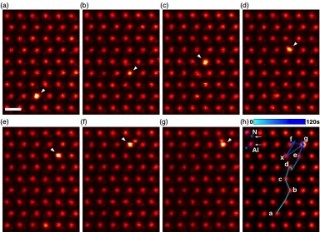The first direct observation of atoms while in movement inside a bulk material has been documented by researchers at the Oak Ridge National Laboratory (ORNL). They were able to directly image the movement or diffusion of single dopant atoms inside a material.
 Selected frames from a sequence of scanning transmission electron microscope images showing the diffusion pathway of a Ce dopant (the bright atom highlighted with a white arrow) as it moves inside a bulk AlN crystal. The final frame overlays the Ce pathway on the Z-contrast image obtained by averaging each frame. Credit: ORNL
Selected frames from a sequence of scanning transmission electron microscope images showing the diffusion pathway of a Ce dopant (the bright atom highlighted with a white arrow) as it moves inside a bulk AlN crystal. The final frame overlays the Ce pathway on the Z-contrast image obtained by averaging each frame. Credit: ORNL
Semiconductors are widely used in modern electronics and their properties can be tuned by adding a small amount of impure atoms, and this process is called as “doping.” In materials research, the study about dopant atoms and their diffusion or movement inside the lattice of the host material is very important.
Material researchers have been using theoretical calculations or indirect macroscopic methods for the study of atomic diffusion. However, they have been able to directly observe single atom diffusion only on the material’s surface and not inside the material. The present research addresses this inability.
Theoretically, considering dopant motion in aluminum nitride, cerium atoms are supposed to have faster diffusion than manganese atoms, though manganese atoms are smaller than cerium atoms. Typically, heavier and larger atoms move slower than atoms that are lighter and smaller.
Manganese atom dopant jump
For studying and imaging the diffusion processes of manganese and cerium dopant atoms, the researchers utilized a scanning transmission electron microscope. From the captured images, they found that the manganese atoms stayed fixed in their place, while the cerium atoms diffused easily through the material.
Cerium atom dopant jump
This study will help choose specific dopants that could increase the lifetime of the devices developed. Further, the knowledge gained could be applied in applications including energy-saving LED lights. In these lights, the atomic movement decides the failure modes, while the color of the LED lights is influenced by the dopants.
This study has been published in Physical Review Letters journal.
References